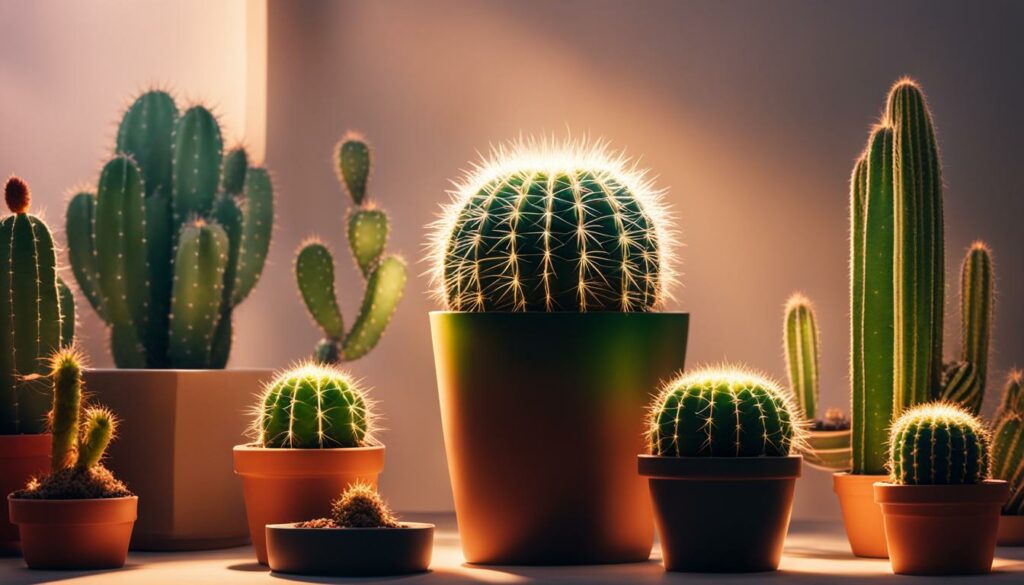When cultivating a cactus, the delicate dance between light and life becomes palpable. Much like a painter meticulously selects hues for their canvas, a cultivator must choose the right grow light to provide an optimal environment for their prickly companions. Cacti, with their resilient exterior and vibrant spirit, beckon for particular attention, especially when grown indoors. The science of selecting suitable grow lights can transform a mundane space into a flourishing desert oasis.
Understanding the fundamental requirements of cacti is paramount. These succulents thrive in arid conditions, preferring bright, direct sunlight. However, there’s a caveat to this desire for intensity; not all indoor settings can replicate the natural brilliance of the desert. Herein lies the importance of grow lights, which can serve as a surrogate sun, nurturing these plants to reach their full potential.
Let us embark on this illuminating journey, exploring the essentials of grow lights tailored specifically for cactus cultivation.
Delving into the Spectrum of Illumination
Light is more than mere brightness; it is a spectrum that bears the capability to affect plant health and growth. For cacti, the most critical wavelengths are found in the red and blue spectrums. The blue light is vital during the vegetative phase, promoting robust growth and vibrant coloration. In contrast, red light plays a significant role in flowering and fruiting phases, encouraging these plants to bloom brilliantly.
Thus, when selecting grow lights, consider Full-Spectrum LED lights or fluorescent tubes. The former provides a balanced spectrum, closely mimicking the sun’s natural light, while ensuring energy efficiency. Not only do these lights cultivate healthier, more resilient plants, but they also often come with adjustable settings for intensity and duration, allowing for customizable growth conditions.
Unveiling the Power of LED Grow Lights
The emergence of LED technology has revolutionized indoor gardening, allowing cacti enthusiasts to harness the full potential of light without incurring exorbitant energy costs. LED grow lights stand out among their incandescent and fluorescent counterparts due to their longevity and low heat emission. This distinctive characteristic is paramount when nurturing cacti since excessive heat can lead to dehydration and stress, ultimately thwarting growth.
Moreover, LED grow lights emit specific light spectrums that can be fine-tuned for the specific needs of various cacti species. For instance, some LED lights come equipped with color-tunable features, allowing the gardener to shift wavelengths as the plant transitions through different growth stages. This adaptability is akin to adjusting a symphony’s melody to create harmony. Grow lights can orchestrate remarkable outcomes when attuned to the specific needs of cacti.
Location, Location, Location
Consider the symbiosis between the cactus and its artificial sun—this relationship is profoundly influenced by where one places the grow lights. Positioning is critical. Cacti love light, and maximizing exposure to their instrumental illuminators is essential. Generally, placing the grow light within 12 to 24 inches of the plant is optimal, but distance can vary based on the light’s intensity and the species of cactus.
It is also important to utilize timers to regulate the light cycle. Cacti, like all plants, require a period of rest, akin to the darkness that envelops the desert at night. A consistent light cycle, often recommended at 12 to 16 hours of light per day, followed by an equal period of darkness, promotes photosynthesis and encourages healthy growth patterns.
Achieving Optimal Conditions: Supplemental Care
While the right grow light is critical, it does not exist in a vacuum. Complementing artificial lighting with proper watering, humidity controls, and ventilation cultivates a harmonious environment that nurtures cacti’s growth. Overwatering is a common nemesis, as cacti are rather conservative water users. They thrive in dry conditions, and their root systems are marvelously designed to soak up moisture when available.
Furthermore, frequent monitoring of temperature and humidity levels ensures a balanced ecosystem. Cacti prefer a temperature range of 70 to 100°F during the day, but they can endure cooler temperatures at night. It’s essential to respect these parameters to coax the best performance from the grow lights. Take note of these microclimates to create a sanctuary of optimal growth for your spiky friends.
The Art of Patience: Observing Growth
Nurturing a cactus with artificial grow lights is akin to cultivating a relationship—it requires patience and care. As you observe your cactus reacting to its new environment, keep in mind the cycles of growth and dormancy that these plants undergo. They may not blossom overnight, but with the right light conditions and nurturing environment, they will gradually thrive, offering a unique appeal that enchants both novice and expert gardeners alike.
In conclusion, investing in the right grow light for cacti is a pivotal choice that directly influences their health and vitality. As one endeavors to recreate the ancestral sunlit landscapes of the desert, mastering the art of light selection becomes a thrilling venture. With the right grow lights and an understanding of their intricate needs, you can foster an indoor garden teeming with life—a veritable oasis in the midst of daily life.





Leave a Comment